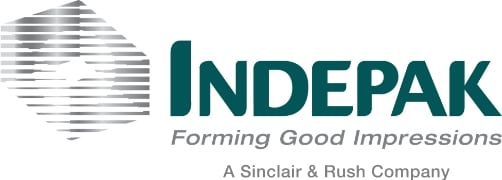Every industry has its own special and unique terminology, and those of us tasked with thermoformed molding are no exception. To help you decipher a bit of our thermoform molding jargon, here are a few of the many common terms we use and what they mean.
Thermoform molding is a process that uses heat to increase the temperature of plastic to the point where it is easy to mold. Once the thermoplastic has been molded, we cool it down and trim off any excess plastic. That, of course, is a very simplified explanation of the thermoform molding process. Before we actually create your product, we design a mold and produce a prototype to ensure that your product or package is exactly right for your needs.
When it comes to thermoform molding, you can often separate this process into two categories. This includes thin-gauge thermoformed molding and thick-gauge thermoformed molding. At Indepak, we use thin-gauge thermoplastics that range from .008” up to .080” and foam materials that range from about 1/16” to ¼”.
In general, when you are creating high volumes of products, such as packaging, bottles, lightweight containers and thermoformed trays, thin-gauge is the ideal choice. Thick gauge thermoform molding is typically used to create very sturdy items and a lower volume of items.
Within the world of thin-gauge thermoform molding, we can create virtually any product, package or tray you might need. This includes items such as clamshells and blister packs, which are two more commonly used terms within the thermoformed molding and packaging industries.
A blister pack is a type of thermoform molding package that includes one or more cavities to hold a product. For instance, individual pills of over-the-counter medicine often are housed in a thermoplastic blister pack with a foil backing. However, countless other products can be sealed in a blister pack. Another example would be a 10-pack of batteries where cavities are formed in thermoplastic to perfectly surround and protect the batteries. This type of blister package might have a paperboard backing rather than foil.
A clamshell is a blister pack that simply folds onto itself, and we see these all the time at retail stores. For instance, a set of headphones might be encased entirely in a thermoplastic clamshell. In this case, the process of thermoform molding also would include the sealing of the clamshell. For a simple clamshell that might hold baked goods or berries, the clamshell might simply snap shut without being sealed. These are just two examples of clamshell packaging, and we create all different sizes and shapes of clamshells for our clients from a wide variety of industries.
Packages created via thermoform molding can be made using a wide variety of thermoplastics. Usually, we simply refer to these plastics by their abbreviations. For instance, polyethylene terephthalate is quite a mouthful, so we just refer to it as PET or PETE. Likewise, acrylonitrile butadiene styrene typically is just called ABS. These are just types of thermoplastic with which we work.
When we begin a thermoformed molding project, one of our first decisions will be to decide what type of thermoplastic will best work for your project. This depends, of course, on the materials used to create your product as well as your budget and the volume of units that you need to have produced. There are many types of thermoplastic, as well as options that include plastic and paperboard or foil, so it’s generally easy to come up with options to suit every client.
Sustainability is another aspect of thermoformed molding with which many of our clients are concerned. The good news is that the majority of materials we use are recyclable, and we also have some renewable and bio-based options. Bio-based includes products that are created or partially created using biological products, forestry products or renewable agricultural materials. We also can use materials that include recycled content, which is a popular option with many of our clients.
These are just a few terms that you might hear as we discuss your project or as you research thermoform molding companies. While the terminology sometimes can seem confusing, we can make it easy for you to understand every aspect of your thermoformed molding and answer any questions that you might have along the way.





